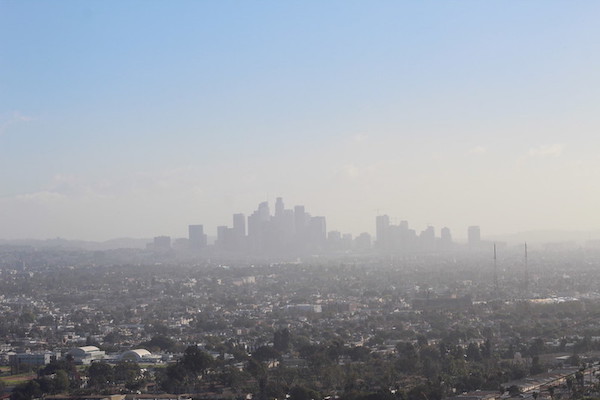SEJournal Online is the digital news magazine of the Society of Environmental Journalists. Learn more about SEJournal Online, including submission, subscription and advertising information.
 |
 |
| The Biden EPA is preparing to revise standards for fine particulates, an especially unhealthy form of particulate air pollution for which motor vehicles are a major source. Above, smog envelopes Los Angeles in 2019. Photo: waltarrrrr via Flickr Creative Commons (CC BY-NC-ND 2.0). |
TipSheet: Particulate Air Pollution — An Old Story Made Newer, and More Local, in 2023
By Joseph A. Davis
Environmental journalists will find particulate air pollution in the news in 2023 — with lots of local angles begging to be dug into.
One reason is that the U.S. Environmental Protection Agency announced on January 6 that it will be revising this key air pollution rule. Another is that particulate air pollution disproportionately harms the most vulnerable: kids, seniors, the poor and minority groups.
While the major media may cover it as a national story (may require subscription), the issue of fine particulate air pollution is built for state and local takes.
Why it matters
Headline writers often translate particulate matter as “soot,” which it does include. But other particulates may also be a problem. They can include dust from roads and fields, certain emissions from combustion sources like power plants, dust from industrial operations or emissions from trucks and cars. Nowadays, wildfires are an important source.
Regardless of its source, particulate pollution is unhealthy for humans. That’s especially true of fine particulates, those smaller than 2.5 micrometers, since they can be drawn more deeply into the lungs when people breathe.
The particles can trigger asthma and other lung conditions like bronchitis. And those with heart or lung disease are particularly vulnerable to PM 2.5 — and aggravations of these diseases can be fatal.
One estimate is that the number of excess deaths in the United States from fine particulates each year is between 85,000 and 200,000, with more of them among people of color.
The backstory
The Clean Air Act requires the EPA to set “primary” (i.e., health-based) standards for PM 2.5 particulates among other pollutants. The agency is also supposed to update its primary air standards every five years. It hasn’t always met that schedule, and it hasn’t always tightened PM 2.5 standards.
The Trump EPA declined to tighten the
PM 2.5 standard. In effect, that means that
the standard has not been updated since 2012.
During the Trump administration, for instance, the EPA declined to tighten the PM 2.5 standard, in keeping with its anti-regulatory philosophy. Finalizing the no-change decision (may require subscription) in December 2020 was one of the last Trump EPA actions.
In effect, that means that the PM 2.5 standard has not been updated since 2012. Now the Biden EPA, under Administrator Michael S. Regan, is updating it with one eye very much focused on environmental justice.
Story ideas
- Are there monitors for PM 2.5 in your state or area? Check this list. What are the measurements in your area?
- Is your area a nonattainment area for PM 2.5? Start by looking at the EPA's Green Book, its list of nonattainment areas for criteria pollutants. Has it been designated a “maintenance area”?
- Would your area be in attainment if the PM 2.5 standards were tightened as much as the EPA wants to tighten them?
- What are the main sources of PM 2.5 in your area? What are the sources of combustion and dust? What can be done to control them? What is being done?
- During wildfire season (however long), is your area subject to ambient atmospheric smoke for significant periods?
- What companies, groups or organizations in your area have opinions about what the standard should be? How will the problems or solutions affect them?
- What is the incidence of asthma in your area? Talk to pediatricians, pulmonologists and emergency room physicians. Talk to public health agencies.
Reporting resources
- The EPA: The agency regulates particulate pollution under the Clean Air Act. Find more on the proposed rule here. Here’s the prepublication text of the proposed rule and the agency’s press release.
- The rulemaking docket: Regulations.gov publishes all documents entered into the record for this rulemaking (among others) once the initial notice is published in the Federal Register. For now, use docket number EPA-HQ-OAR-2015-0072.
- American Lung Association: An advocacy nonprofit that works to reduce air pollution and protect lung health.
- AirNow. This multi-agency resource (led by the EPA) offers near real-time measurements and forecasts for air pollution, including PM 2.5. The map format makes it easy to use.
- State air pollution agencies: State agencies are responsible for most enforcement of PM 2.5 standards.
Joseph A. Davis is a freelance writer/editor in Washington, D.C. who has been writing about the environment since 1976. He writes SEJournal Online's TipSheet, Reporter's Toolbox and Issue Backgrounder, and curates SEJ's weekday news headlines service EJToday and @EJTodayNews. Davis also directs SEJ's Freedom of Information Project and writes the WatchDog opinion column.
* From the weekly news magazine SEJournal Online, Vol. 8, No. 3. Content from each new issue of SEJournal Online is available to the public via the SEJournal Online main page. Subscribe to the e-newsletter here. And see past issues of the SEJournal archived here.













 Advertisement
Advertisement 



